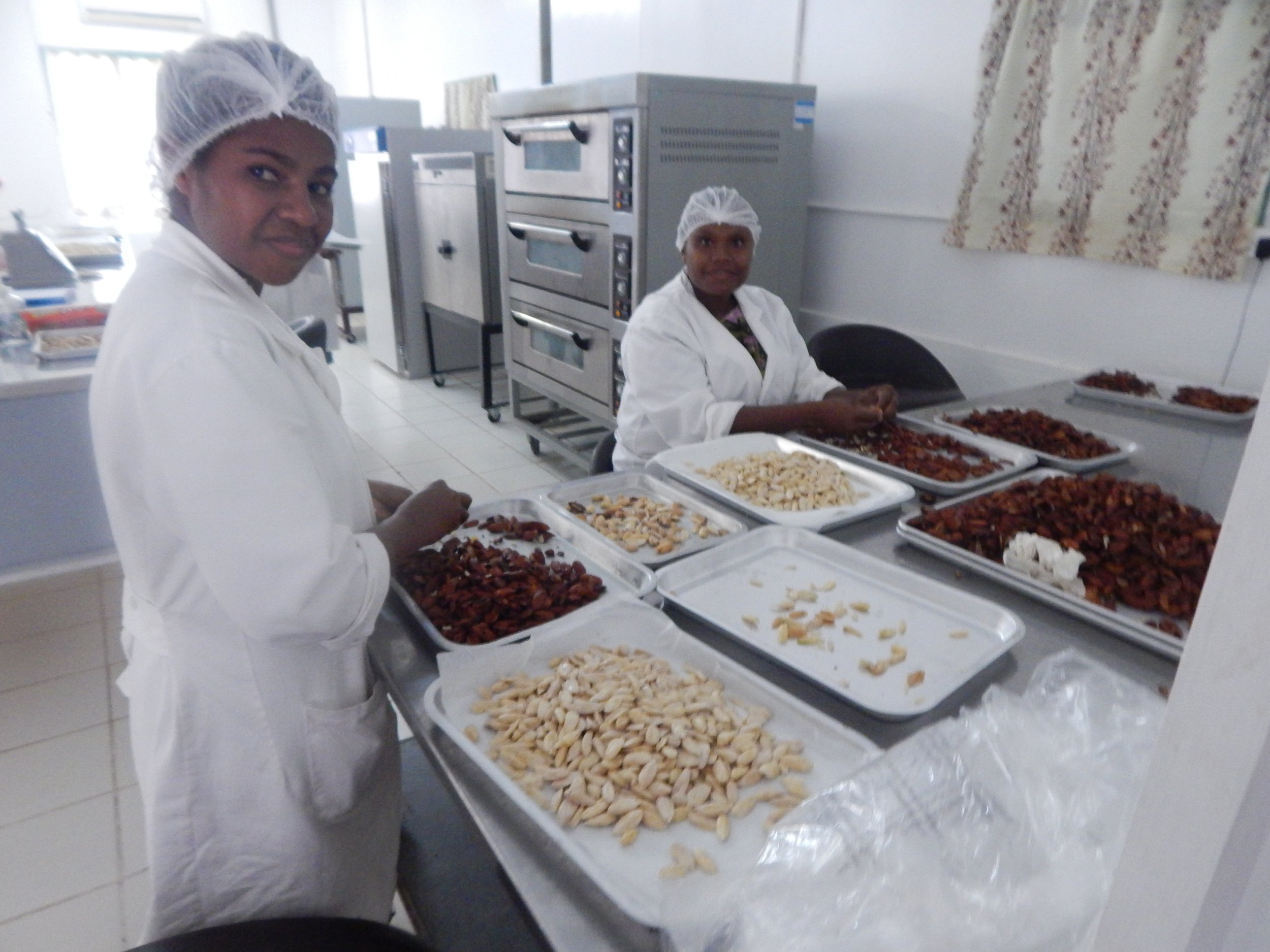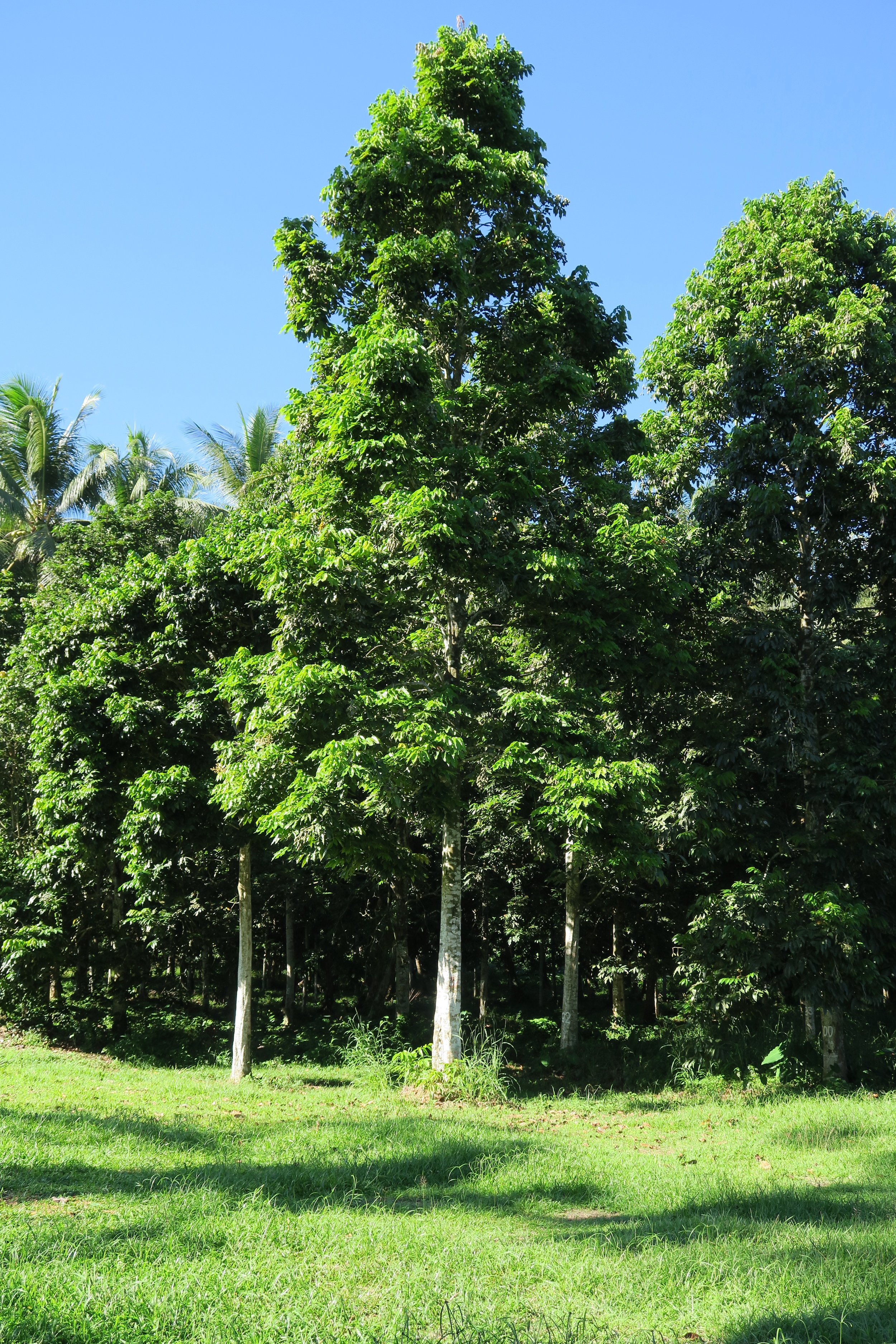Canarium nut (Canarium indicum)
Canarium indicum fruits.
by Shahla Hosseini-Bai, Helen M. Wallace, Craig JohnS, Dalsie Hannet, Birte Komolong, Elektra Grant and Godfrey Hannet
Background
Forest foods have high nutritional value (Bai et al. 2017a, 2019a,b, 2021) and are one of the underutilized sources of food and nutritional security in the Pacific. Kernels of nut trees in particular are rich in protein, micro-nutrients and beneficial fatty acids. Additionally, tree nuts have a prolonged shelf life when processed and stored properly (Gama et al. 2018) and can then be sold or consumed off-season.
Canarium indicum (canarium) is an indigenous multi-purpose tree, used as a food source and timber, and is now also being used in agroforestry as shade tree for cash crops. Canarium trees produce kernels that are rich in nutrients like iron and zinc. The kernels contain approximately 50% oleic acid, a healthy fatty acid, and are also rich in antioxidants (Leakey et al. 2008; Bai et al. 2017a, 2019a,b).
Currently, the commercialisation of canarium nuts is progressing with support from the Australian Centre for International Agricultural Research (ACIAR) and other projects targeted to Pacific Island communities. Semi-commercial processing methods have been developed and a growing industry of small and micro-enterprises has been established (Bai et al. 2017c, 2021; Wallace et al. 2021). This has improved the accessibility of canarium nuts and allowed for purchasing to be more convenient, particularly for urban dwellers, thus improving the nutritional intake available to a wider community.
Canarium indicum kernels.
Plant and fruit descriptions
Canarium indicum is a forest tree naturally occurring in Eastern Indonesia and the Pacific. The tree is used in agroforestry systems as source of timber, shade and for its edible nuts (Bai et al. 2017b; Hosseini-Bai et al. 2019; Bai et al. 2022). Hence, this tree has the potential to produce short- and long-term economic benefits for small scale farmers.
Canarium fruit is produced seasonally. The outer layer includes an excocarp, changing color from green to purple when ripe, followed by a fleshy mesocarp, a hard shell and then the kernel which is protected by a brown testa (Walton et al. 2014). A series of case studies have been undertaken to explore nutritional value of this species.
The key nutritional information of Canarium indicum
Traditional nut wrapping in banana leaves in Bougainville.
Tree to tree variations in the nutrient composition of kernels has been reported (Leakey et al. 2008). On average, canarium kernels contain 14% crude protein, essential nutrients including 81 mg/Kg iron and 50 mg/Kg zinc, and 50% oleic acid. For example, a handful of canarium nuts (50 g) provides about 70% of the adult male recommended daily intake of magnesium and phosphorus and around 50% of the iron (Bai et al. 2019). Canarium kernels also contain antioxidants and are rich in vitamin E.
Canarium nuts are part of traditional diets where the species is found. The kernels are traditionally consumed fresh or added as an ingredient to local food. Commercialization of this species has provided opportunity for communities living in urban areas to have access to this nutritious nut.
Cracking Canarium nuts.
Nut processing.
Traditional and current commercialization conditions
Traditionally, canarium nuts are cracked for home consumption or sold in local markets by women. Nut collection and processing is considered women’s work. For sale, they wrap the fresh kernels into banana leaves and need to sell the product within 48 h before molds start growing.
A series of projects funded by Australian Centre for International Agricultural Research (ACIAR) in collaboration with Papua New Guinea National Agricultural Research Institute (NARI) established a pilot factory to commercialise the canarium nuts in Papua New Guinea (PNG) in 2014. The semi-commercial processing methods have now been established and the nuts have been supplied to formal markets since 2018. The processors supply nuts to formal markets in PNG. Very small-scale exports have also been trialed. Most nuts are sourced from natural forests or trees planted in villages and home gardens rather than plantations. Currently, a range of various value-added products exist in the market that have helped to improve the livelihood of the Pacific people. The range of products include canarium meal, flour, oil, cakes and cookies. Canarium oil is a valuable oil already used in various cosmetic products such as soaps, creams, lotions or as a specialty cooking oil. Currently, these canarium products mainly target tourists and suitcase markets, particularly in Vanuatu.
Challenges
The potential of canarium nut as a novel crop to enhance income generation and improve diets at local, domestic and export markets has been demonstrated (Wallace et al. 2021). Challenges remain to fully realize this potential. To scale-up commercialization of this nut, the major challenges to overcome include:
Commercilised Canarium nuts.
Lack of consistent supply, the scale of potential supply is unknown in the Pacific.
Lack of private sector investment
Awareness and capacity along the value chain on food safety and hygiene practices
Improvements in the efficiency of the value chain
Lack of commercial mechanized processing methods
The knowledge of traditional methods of processing nuts on the village has also been declining with younger generations and needs to be re-invigorated. Further, there is little awareness on the nutritional benefits of canarium nuts. Sometimes, nutritional information is available but it is not in a useful format and hence it is not easy to interpret the information.
Canarium indicum tree.
Conservation
Canarium indicum has been domesticated for over 60,000 years in the Pacific (Thomson and Evans 2006). Over time, farmers have been selecting the best varieties to plant on their farms or in their home gardens and valuable trees have conserved and propagated for generations. However, traditional knowledge on forest food sources is diminishing and canarium trees are often felled for timber for building houses due to high population growth rates. Uncontrolled logging is further threatening wild canarium resources in the forests. Legislation on conservation of natural resources in general is weak in the Pacific.
There are also currently no provisions through domestic laws or policies that protect farmer rights on the use of such natural resources owned by indigenous communities. In preparing to sign up to the Nagoya Protocol under the Convention of Biological Diversity, PNG has developed a draft legislation and policy to domesticate provisions of the Nagoya Protocol on access and benefit sharing of the use of biological natural resources, including canarium. Passing of the legislation will provide a better basis for the conservation and equitable use of canarium nuts to indigenous communities in PNG.
Concluding remarks
This rainforest tree species has shown great potential to improve food and nutrition security and play a role in income generation for people living in villages in the Pacific. The increased availability of nuts from this traditional tree also has potential to improve the nutritional security of the wider community of urban dwellers. Currently, most nuts are harvested from the rainforest or home gardens, and creating a value for these nuts helps to protect these trees from logging.
Click here to download a summary table of the case study.
References
Bai, S.H., Brooks, P., Gama, R., Nevenimo, T., Hannet, G., Hannet, D., Randall, B., Walton, D., Grant, E., and Wallace, H.M., 2019a. Nutritional quality of almond, canarium, cashew and pistachio and their oil photooxidative stability. Journal of Food Science and Technology, 56, 792-798.
Bai, S.H., Darby, I., Nevenimo, T., Hannet, G., Hannet, D., Poienou, M., Grant, E., Brooks, P., Walton, D., Randall, B., 2017. Effects of roasting on kernel peroxide value, free fatty acid, fatty acid composition and crude protein content. PloS one, 12, e0184279.
Bai, S.H., Nevenimo , T., Hannet, G., Hannet, D., Jones, K., Trueman, S.J., Grant, E., Walton, D.A., Randall, B., and Wallace, H.M., 2019b. Freezing, roasting and salt dipping impacts on peroxide value, free fatty acid and fatty acid composition of nut kernels. Acta Horticulturae, 1256, 71-75.
Bai, S.H., Trueman, S.J., Nevenimo, T., Hannet, G., Bapiwai, P., Poienou, M., and Wallace, H.M., 2017b. Effects of shade-tree species and spacing on soil and leaf nutrient concentrations in cocoa plantations at 8 years after establishment. Agriculture, Ecosystems & Environment, 246, 134-143.
Bai, S.H., Nevenimo, T., Hannet, G., Hannet, D., Jones, K., Trueman, S.J., Grant, E.L., Walton, D.A., Randall, B. and Wallace, H.M., 2017c, October. Freezing, roasting and salt dipping impacts on peroxide value, free fatty acid and fatty acid concentrations of nut kernels. In VI International Conference Postharvest Unlimited 1256 (pp. 71-76).
Bai, S.H., Hannet, D., Hannet, G., Grant, E., Komolong, B., Jones, K. and Wallace, H.M., 2021, October. Effects of fruit depulping on kernel quality of Canarium indicum. In V International Conference on Postharvest and Quality Management of Horticultural Products of Interest for Tropical Regions 1340 (pp. 145-148).
Bai, S.H., Gallart, M., Singh, K., Hannet, G., Komolong, B., Yinil, D., Field, D.J., Muqaddas, B. and Wallace, H.M., 2022. Leaf litter species affects decomposition rate and nutrient release in a cocoa plantation. Agriculture, Ecosystems & Environment, 324, 107705.
Gama, T., Wallace, H.M., Trueman, S.J., Hosseini-Bai, S., 2018. Quality and shelf life of tree nuts: A review. Scientia Horticulturae, 242, 116-126.
Hosseini-Bai, S., Trueman, S.J., Nevenimo, T., Hannet, G., Randall, B. and Wallace, H.M., 2019. The effects of tree spacing regime and tree species composition on mineral nutrient composition of cocoa beans and canarium nuts in 8-year-old cocoa plantations. Environmental Science and Pollution Research, 26, 22021-22029.
Leakey, R., Fuller, S., Treloar, T., Stevenson, L., Hunter, D., Nevenimo, T., Binifa, J. and Moxon, J., 2008. Characterization of tree-to-tree variation in morphological, nutritional and medicinal properties of Canarium indicum nuts. Agroforestry Systems, 73, 77-87.
Thomson, L.A. and Evans, B., 2006. Canarium indicum var. indicum and C. harveyi (canarium nut). Traditional Trees of Pacific Islands: Their Culture, Environment and Use, pp.209-226.
Wallace, H., Hosseini Bai, S., Komolong, B., Nevenimo, T., Waai, C., Hannet, D., Hannet, G., Grant, E., Hodges, B., Kill, E., Randall, B., Carter, J., Jones, K., Simos, T., and John, C., 2021. Enhancing private sector-led development of the Canarium industry in PNG. ACIAR final report, project FST/2014/099. Available here.
Walton, D.A., Randall, B.W., Poienou, M., Moxon, J. and Wallace, H.M., 2014. August. Maturity indices of Canarium indicum (Burseraceae) nuts. In XXIX International Horticultural Congress on Horticulture: Sustaining Lives, Livelihoods and Landscapes (IHC2014): 1109 (pp. 17-22).







